Newcastle MathsJam May 2013 Recap
If I type very quickly, I can get this recap posted before June’s MathsJam starts. Hi-ho, silver!
The Correntator
I found a rather interesting mechanical calculator in Tynemouth market. It’s called a Correntator, and it adds up old-fashioned money. You add amounts by sticking a stylus in one of the tracks and dragging it down. Little hooks at the ends of the track do the carrying-over for you. It’s rather sweet, in a limitedly-useful way.
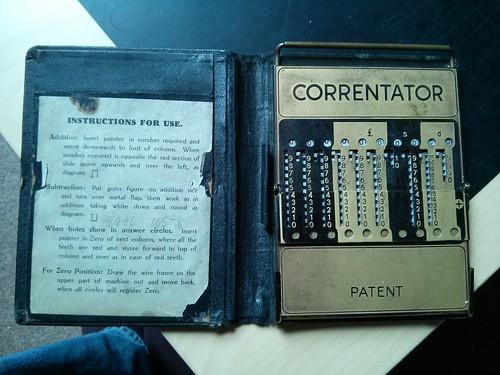
I also brought in my 1811 arithmetic textbook to provide a source of problems for people to solve.
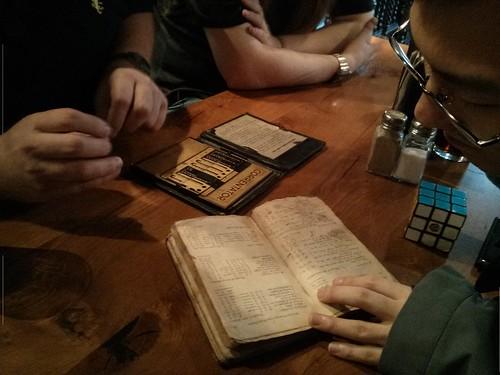 We talked for a bit about how much harder things were with old units, meaning people had to spend more time remembering rules for doing simple things and never got on to more advanced and fun topics. Someone said, “Use of the correct concepts helps.” Apart from the switch to metric, someone pointed out that thinking of the trig rules in terms of complex numbers makes a whole load of problems way easier.
We talked for a bit about how much harder things were with old units, meaning people had to spend more time remembering rules for doing simple things and never got on to more advanced and fun topics. Someone said, “Use of the correct concepts helps.” Apart from the switch to metric, someone pointed out that thinking of the trig rules in terms of complex numbers makes a whole load of problems way easier.
Ji pointed out that the Chinese version of the Correntator is the abacus.
An unexisting journal article about a hoax
I mentioned that I had been unable to track down a copy of the paper “An April Fool’s Hoax” by Stan Wagon, purportedly published in Mathematica in Education and Research. It’s widely cited, but the links on the journal’s old website are all broken, and Springer-Verlag denies all knowledge of the journal. I can’t work out whether the article about a hoax is itself a hoax. Anyway, it’s supposed to be about the hoax Martin Gardner famously perpetrated in his Mathematical Games column where he claimed that Ramanujan’s constant is an integer.
Factorising commuters
I mentioned that I had started factorising the number of my Metro carriage on the way into work each morning as a way to pass the time. It took me a long time to factor 4051, because it’s a prime! I’ve written down, “Is there a better method than the sieve of Eratosthenes for primality testing/factoring?” Yes.
More cubes!
Steven brought in yet more weird puzzle cubes…
… and David finally solved the puzzle he started in April.
A random walk on slides
We talked about the rather silly random walk on slides that some Carnegie Mellon students did. We thought it was perfect Big MathsJam fodder, and thought that each local MathsJam could prepare one slide for a presentation to be given at the annual conference in November. Let’s make it happen!
Another way of counting
Cheltenham posted this puzzle on Twitter:
Show that every number appears in this grid exactly once.
After thinking about it for a bit, click here to see the solution.
A rubbish way of calculating
John told us about this identity for
A quick googling tells me that it’s called the Gregory series, and it converges really, really slowly. John told us that even if you sum up the first 5 million terms in the series, it’s wrong in the 7th and 21st (and more) digits. He asked if there was an integer sequence for the number of terms you need to calculate to get
It’s sequence A126809, and there’s bad news: you don’t get the 7th digit correct until you’ve worked out 18,660,270 terms of the series sum!
David goes showbiz
David arrived quite late. He said that he had passed up dinner with 70s megaband Journey to come to MathsJam. And he wasn’t lying! He left after a while claiming he was bored. David’s too showbiz for us now 🙁
Simon!
I forgot to bring Simon the snake! He had been in my back pocket for a month until the morning of MathsJam, but then I took him out and put him on my desk and now I don’t know where he is. Poor Simon.
John’s rather clever games
John brought a couple of games he’d bought from nestorgames. Specifically, he brought Feed the Ducks and Coffee. The game of Feed the Ducks took absolutely ages to play, and eventually I think everyone just gave up.
Abuse of notation
We talked about the bad hexadecimal numbers. I can’t remember how we found them, but the idea is this: instead of using
Equally appalling is dismal arithmetic. The idea this time is to respond to complaints that students learning to do addition and multiplication on paper can’t do carrying-over by making sure that it never happens. You follow the same algorithms as for normal addition and multiplication, but now whenever you add two digits you just take the largest one, and when you multiply two digits you take the smallest one. It works, as long as you don’t mind about associativity or distributivity or anything like that. I finally satisfied myself that 19 is a prime in dismal arithmetic.
Mad Abel!
We played a few rounds of Mad Abel. Enthusiasm was down on last time we played it. I still think it’s great, anyway.
Wobbly table legs
Edinburgh tweeted about the wobbly garden table problem, which we’ve discussed before. There is a similar problem: can you always find somewhere to land a lunar module with 3 legs so that it’s level? Apparently this is known as Knaster’s problem.
Art!
I talked about my quest to find art to decorate Newcastle University’s maths department. Andrew has written down the name Radmila Sazdanovic.
Surveying
Finally, someone mentioned a device which can calculate the area of a shape after you trundle it around the boundary, using either Green’s theorem or Stokes’ theorem (we weren’t sure which). As far as I can tell, it’s called a planimeter. Pretty clever!
Phew! Done with 30 minutes to spare. Just enough time to saunter down to the Charles Grey pub in the sunshine and get myself a drink.
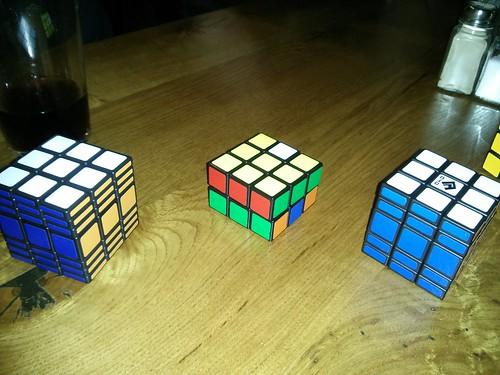
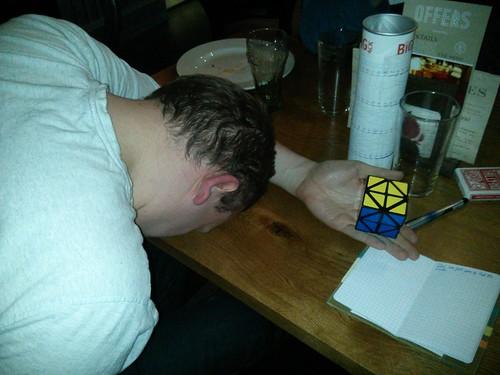
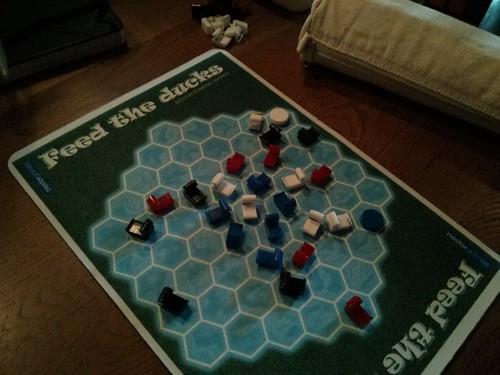
Comments
Comments
John
The delightful bit about the Gregory series is that if you truncate it to
Truncate at half of a different power of 10, and the same errors appear at different places. So if you know where it’s wrong, you can take digits from the other truncation and get a surprisingly accurate result.
I got it from http://www.carma.newcastle.edu.au/jon/pi-2010.pdf
Stan Wagon
The journal MiER is now defunct and, yes, hard/impossible to find. But all that material, and much much more, including 3-colorings of Penrose tilings, and a 4-coloring of all 3300 counties in the USA, is in Chap 17 of my book Mathematica in Action (3rd ed, but also in 2nd ed). More recent news: There is a concept called fractional coloring. I have obtained a quite pretty 3.5 coloring of the US states, and 3.5 is best possible. Contact me for info on any of this.
Christian Perfect
Aha, that’s great! Newcastle University’s library has two copies of your book, so I’ll go down there and fetch one.
I’ll email you about the fractional colouring.
Hans Havermann
“Anyway, it’s supposed to be about the hoax Martin Gardner famously perpetrated in his Mathematical Games column where he claimed that Ramanujan’s constant is an integer.”
Gardner’s 1975 column (reprinted in “Time Travel”) was actually six separate hoaxes, Ramanujan’s “integer” constant being one and a counter-example to the four-color-map theorem, another. Stan Wagon used Mathematica to show that the counter-example could in fact be 4-colored. That Mathematica notebook is available at the bottom of this page: http://library.wolfram.com/infocenter/Articles/1157/
Christian Perfect
Yes, that’s right! I should keep better notes. I could only find the Ramanujan constant hoax when I was googling for Wagon’s article, so even though it didn’t sound right I assumed that was what I was originally looking for.